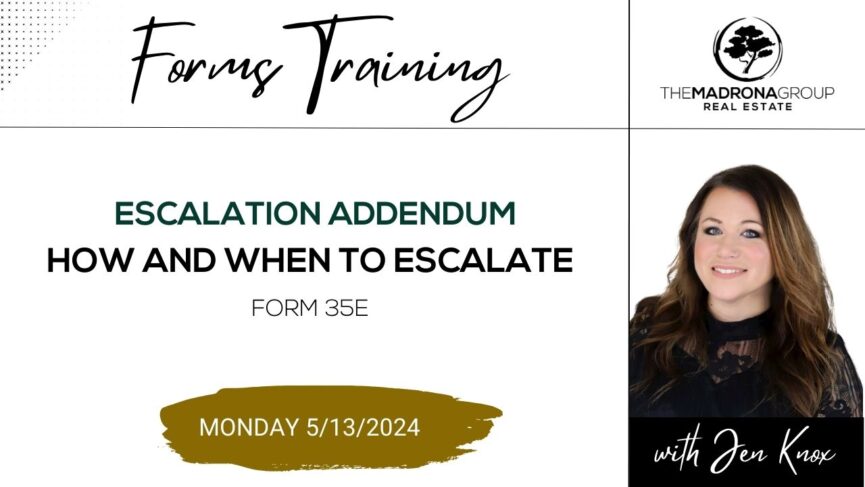Navigating the world of real estate offers can be complex, especially in a competitive market. One tool that can give your client a strategic edge is the Escalation Addendum, Form 35E. This guide will break down when and how to use this form effectively, ensuring your offers are both competitive and compliant.
How and When To Use the Escalation Addendum Form 35E Video
Understanding the Purpose and Timing of the Escalation Addendum
The Escalation Addendum is designed to automatically increase a buyer’s offer to outbid competing offers, up to a specified maximum price. This form is particularly useful in hot markets where multiple offers are common. It allows buyers to set themselves apart by indicating their willingness to escalate their purchase price within defined limits.
When to Use an Escalation Addendum:
- Hot Markets: When multiple offers are expected, and your buyer wants to stay competitive.
- Strategic Advantage: When the buyer is willing to go above the list price but wants to ensure they don’t overpay unnecessarily.
- Clear Budget Limits: When the buyer has a maximum price they are willing to pay and wants to automate the bidding process within that range.
However, it’s important to use this form with caution. The Northwest MLS advises against using it due to the inherent risks, but if you decide to proceed, ensure you have a clear strategy and accurate calculations.
Step-by-Step Guidance on Filling Out The Escalation Addendum Form 35E
Here’s a detailed walkthrough to help you complete the Escalation Addendum correctly:
- Form Overview:
- Page 1: Start by identifying the property and the parties involved. Include the initial offer price and the maximum price the buyer is willing to pay.
- Page 2: Outline the increment by which the offer will escalate over the highest competing offer.
- Key Sections:
- Purchase Price: Clearly state the base purchase price and the maximum price. This ensures there’s no confusion about how high the buyer is willing to go.
- Increment Amount: Specify the amount by which the offer will escalate. This could be a fixed dollar amount (e.g., $1,000) over the highest competing offer.
- Verification of Competing Offers: The seller must provide proof of competing offers. Ensure that this proof includes all relevant details, such as the buyer’s name, offer price, and terms.
- Execution:
- Ensure all parties sign the addendum and that it’s attached to the purchase and sale agreement. Mutual acceptance of the terms is crucial for the escalation to be binding.
Criteria for a Valid Offer That Can Escalate
Not all offers can escalate. Here’s what makes an offer valid for escalation:
- Bonafide Competing Offers: The competing offers must be genuine and enforceable. They cannot be contingent on the sale of another property unless that sale is already under contract.
- Documentation: The competing offer must be fully documented and provided to the buyer. Any missing information can invalidate the escalation.
- Compliance with Terms: The competing offer must meet all the criteria set forth in the Escalation Addendum, such as closing within a specified timeframe.
Handling Incorrect Calculations and Avoiding Common Errors
What happens if your calculations are wrong? Missteps can lead to costly mistakes, so it’s essential to double-check your figures.
- Calculation Errors: If there’s an error, the buyer can challenge the calculation within a specified timeframe (typically three days). The seller must then provide correct calculations or agree to terminate the contract.
- Action Steps: If you identify a mistake, notify the seller immediately and provide your corrected calculation. Ensure all communications are documented.
Real-Life Scenarios to Help You Navigate Various Situations
To bring the theory to life, let’s look at a couple of real-world examples:
Example 1: Competing Offers
- Offer A: $500,000, willing to escalate by $1,000, up to $520,000.
- Offer B: $510,000, no escalation.
In this scenario, Offer A will escalate to $511,000, beating Offer B.
Example 2: Calculating Net Offers
- Offer A: $500,000, willing to escalate by $1,000, up to $520,000, but includes a $10,000 buyer credit.
- Offer B: $510,000, no escalation, no credits.
Here, the net offer for A is effectively $490,000 after credits. Offer B remains stronger at $510,000, unless Offer A’s gross value can escalate sufficiently to offset the credit.
Detailed Insights into Using Form 35E
Understanding the nuances of the Escalation Addendum is crucial for its effective use. Here are some in-depth insights:
Filling Out the Form Correctly:
- Initial Offer Price: This is the starting point of the buyer’s offer before any escalation. Ensure this is a competitive offer in itself.
- Maximum Price: This is the cap the buyer is willing to reach. It’s crucial to set this realistically based on market conditions and the buyer’s budget.
- Escalation Amount: This should be a sensible increment that ensures the buyer’s offer stays competitive without overpaying.
Verification and Documentation:
- Proof of Competing Offers: Sellers must provide unredacted copies of competing offers. This transparency is vital to ensure the escalation process is fair and accurate.
- Timelines: Ensure all deadlines are met. For example, the seller must provide proof of a competing offer within the timeframe specified in the addendum.
Handling Discrepancies:
- Dispute Resolution: If there’s a disagreement over calculations, use the form’s dispute resolution mechanisms. This often involves providing your calculations and proof to the seller and allowing them to correct any errors or terminate the contract.
- Documentation: Keep thorough records of all communications and calculations. This is crucial if any disputes arise.
Real-Life Examples and Scenarios:
- Escalating with Credits: If a competing offer includes buyer credits, ensure these are factored into your calculations. For example, if a $500,000 offer includes a $10,000 buyer credit, the net offer is $490,000.
- Multiple Competing Offers: When there are several competing offers, compare net offers after factoring in any credits or contingencies. This ensures you are escalating against the true highest offer.
Conclusion
The Escalation Addendum (Form 35E) can be a powerful tool in the right circumstances, but it requires careful handling. By understanding when to use it, filling it out correctly, ensuring offers are valid, and avoiding common errors, you can make your client’s offer stand out in a competitive market. Remember, precise calculations and clear communication are key to leveraging this form effectively.
In the dynamic world of real estate, staying ahead of the competition is essential. The Escalation Addendum can give you that edge, ensuring your client’s offers are both attractive and competitive. Whether you’re dealing with multiple offers or navigating complex market conditions, mastering Form 35E will help you secure better deals for your clients.
If you have any questions or need further guidance on using the Escalation Addendum, feel free to reach out. Stay competitive and confident in your real estate transactions!
Share this post!




